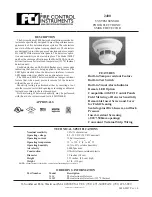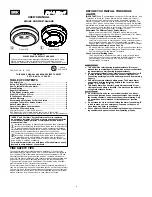
Model: C89201 www.lacrossetechnology.com/support
7
Moon Phase
The moon phase is based on the Gregorian calendar and the year, month and date set (manually or by
the WWVB signal). Most Internet moon phase calculations are based on the lunar calendar.
•
Waxing
indicates growing or expanding illumination and happens after a new moon.
•
Waning
indicates decreasing illumination and occurs after a full moon.
•
Crescent
refers to the moon being less than half illuminated. Crescents can be waning or
waxing.
•
Gibbous
describes a moon phase when more than half is illuminated. Gibbous can be waxing or
waning.
•
New Moon
occurs when the moon is between the earth and sun, so the illuminated portion of the
moon is on the back side facing the sun and we cannot see it. After a new moon, the illuminated
portion will increase or wax until the full moon occurs.
•
Full Moon
occurs when the earth, moon and sun are in approximate alignment, with the moon
and the sun on opposite sides of the earth. The illuminated portion of the moon faces the earth,
giving us complete visibility of one side of the entire moon. After a full moon, the illuminated
portion will decrease or wane until the new moon occurs.
•
First Quarter
and
Last Quarter
moons occur when the moon is at a 90 degree angle to the earth
and sun. We see half of the moon illuminated and the other half is in shadow.
WWVB Radio-Controlled Time
The NIST radio station, WWVB, is located in Ft. Collins, Colorado and transmits the exact time signal
continuously throughout the United States at 60 kHz. The signal can be received up to 2,000 miles away
through the internal antenna in the atomic alarm clock. However, due to the nature of the Earth’s
Ionosphere, reception is very limited during daylight hours.
The WWVB reception icon with full signal strength will appear on screen if the reception of
atomic time is successful.
•
When powered up, the Atomic Alarm Clock will automatically try to receive the WWVB
signal every two hours until the clock receives the WWVB time signal. Then will update at UTC 7:00,
8:00, 9:00. 10:00, or 11:00, it will not look for an update again until the next day.
•
In normal mode, hold the
-
button for three seconds to enter manual searching for the signal.
•
In reception mode, hold the
-
button for three seconds to exit searching for the atomic signal.
ATOMIC SIGNAL SEARCH:
The LCD backlight and USB charging port will momentarily turn off while the station searches for the
atomic signal. The alarm clock will search every 2 hours until the WWVB time signal is received. After
reception, this alarm clock will only search for the atomic signal after midnight.
Note:
In case the atomic alarm clock is not able to detect the WWVB-signal (disturbances, transmitting
distance, etc.); the time can be manually set in the program menu.
NIST radio station, WWVB, is
Position the Atomic Alarm Clock
The atomic alarm clock should be placed near an exterior wall with the front or back facing toward Ft.
Collins, Colorado for best WWVB reception. Choose a location 6 feet or more from electronics such as
cordless phones, gaming systems, televisions, microwaves, routers, baby monitors, etc., which can
prevent signal reception.



























